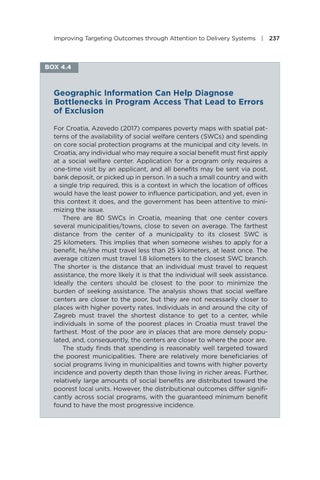Improving Targeting Outcomes through Attention to Delivery Systems | 237
BOX 4 .4
Geographic Information Can Help Diagnose Bottlenecks in Program Access That Lead to Errors of Exclusion For Croatia, Azevedo (2017) compares poverty maps with spatial patterns of the availability of social welfare centers (SWCs) and spending on core social protection programs at the municipal and city levels. In Croatia, any individual who may require a social benefit must first apply at a social welfare center. Application for a program only requires a one-time visit by an applicant, and all benefits may be sent via post, bank deposit, or picked up in person. In a such a small country and with a single trip required, this is a context in which the location of offices would have the least power to influence participation, and yet, even in this context it does, and the government has been attentive to minimizing the issue. There are 80 SWCs in Croatia, meaning that one center covers several municipalities/towns, close to seven on average. The farthest distance from the center of a municipality to its closest SWC is 25 kilometers. This implies that when someone wishes to apply for a benefit, he/she must travel less than 25 kilometers, at least once. The average citizen must travel 1.8 kilometers to the closest SWC branch. The shorter is the distance that an individual must travel to request assistance, the more likely it is that the individual will seek assistance. Ideally the centers should be closest to the poor to minimize the burden of seeking assistance. The analysis shows that social welfare centers are closer to the poor, but they are not necessarily closer to places with higher poverty rates. Individuals in and around the city of Zagreb must travel the shortest distance to get to a center, while individuals in some of the poorest places in Croatia must travel the farthest. Most of the poor are in places that are more densely populated, and, consequently, the centers are closer to where the poor are. The study finds that spending is reasonably well targeted toward the poorest municipalities. There are relatively more beneficiaries of social programs living in municipalities and towns with higher poverty incidence and poverty depth than those living in richer areas. Further, relatively large amounts of social benefits are distributed toward the poorest local units. However, the distributional outcomes differ significantly across social programs, with the guaranteed minimum benefit found to have the most progressive incidence.


